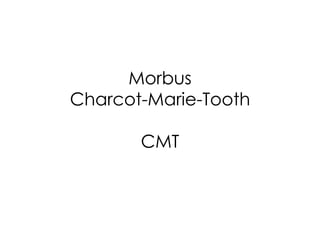
CMT
- 2. Dr. med. Yvonne Spiess Fachärztin FMH für Neurologie 00.00.2011
- 3. Hereditäre motorisch-sensible Neuropathie Typ I HMSN I Neurale Muskelatrophie
- 6. Symptome
- 7. Befunde
- 12. Ursache
- 15. Genetik
- 17. Charcot-Marie-Tooth (CMT) Disease Phenotypes, Their Genetic Forms of Inheritance, and Their Mapped Genes and Loci
- 18. Epidemiologie
- 19. Verlauf
- 20. Abklärungsgang
- 23. Therapie
- 29. Orthopädie
- 31. Vorsicht
- 33. Schweizerische Gesellschaft für Muskelkranke SGMK Kanzleistrasse 80 8004 Zürich Telefon +41 (0)44 245 80 30 Fax +41 (0)44 245 80 31
- 34. Myosuisse ist das Netzwerk aller Fachleute und Organisationen, die sich in der Schweiz für Menschen mit einer neuromuskulären Krankheit einsetzen
Notas del editor
- In 1886 two French neurologists (Charcot and Marie) and one English neurologist (Tooth) described a set of characteristic physical symptoms to which was later given their names - Charcot-Marie-Tooth disease (CMT). Tooth realized that problem was in the nerves not the muscle.
- Die Krankheit wird auch "Peroneus-Muskel-Atrophie (PMA)" genannt, weil der Peroneusmuskel, der vorne am Schienenbein herabläuft, gewöhnlich als erster Muskel betroffen ist. Ein geschwächter Peroneusmuskel kann zu einem unsicheren Gang führen: Der Fuss hängt schlaff herunter, man stolpert leicht, und man muss das Bein vom Oberschenkel aus anheben, bis auch die Zehen sich vom Boden lösen, und der Fuss setzt patschend wieder auf dem Boden auf - wenn man Glück hat, mit der Ferse zuerst.
- Die häufigste neurogenetische Erkkrankung, autosomal dominant, Mutation Chromosom 17 25 Gene
- Etwa 50% aller CMT-Erkrankungen sind auf Duplikationen des PMP22-Gens (CMT1A) zurückzuführen, alle anderen Gendefekte sind wesentlich seltener.
- Figure 1. Charcot-Marie-Tooth (CMT) Disease Phenotypes, Their Genetic Forms of Inheritance, and Their Mapped Genes and Loci. CMT is divided in two major phenotypic types - glial myelinopathy (CMT type 1) and neuronal axonopathy (CMT type 2) - according to electrophysiological, clinical, and nerve-biopsy evaluations. Each type can be inherited in a dominant, recessive, or X-linked fashion. There are also autosomal dominant intermediate forms of CMT that can have features of both axonal and demyelinating neuropathies. Several genes have been associated with CMT disease to date, and other loci have been associated and mapped but their genes not yet identified. MPZ, GDAP1, and GJB1 are known to be associated with CMT type 1, but select mutations in these genes can also cause CMT type 2; NEFL is known to be associated with CMT type 2, but select mutations convey a CMT type 1 phenotype. Dominant intermediate forms of CMT have been reported to be associated with MPZ mutations. Specific recessive alleles related to CMT have also been reported for EGR2 and PMP22. Of the 31 genes in 39 known CMT loci, only 15 genes are currently available for clinical testing. Current evidence-based clinical guidelines for distal symmetric polyneuropathy recommend genetic testing consisting of screening for common mutations, including the CMT1A duplication copy-number variant and point mutations of the X-linked GJB1 gene.9
- Inzidenz 40/100000? Prävalenz EU - 40
- Lebenserwartung
- There is still no eff ective drug therapy for CMT.72,73 Supportive treatment is limited to rehabilitative therapy and surgical treatment of skeletal deformities and soft-tissue abnormalities. The therapeutic management requires a multidisciplinary approach, with a close collaboration between the neurologist and other professional fi gures.6
- There is still no eff ective drug therapy for CMT.72,73 Supportive treatment is limited to rehabilitative therapy and surgical treatment of skeletal deformities and soft-tissue abnormalities. The therapeutic management requires a multidisciplinary approach, with a close collaboration between the neurologist and other professional fi gures.6
- There is still no eff ective drug therapy for CMT.72,73 Supportive treatment is limited to rehabilitative therapy and surgical treatment of skeletal deformities and soft-tissue abnormalities. The therapeutic management requires a multidisciplinary approach, with a close collaboration between the neurologist and other professional fi gures.6
- There is still no eff ective drug therapy for CMT.72,73 Supportive treatment is limited to rehabilitative therapy and surgical treatment of skeletal deformities and soft-tissue abnormalities. The therapeutic management requires a multidisciplinary approach, with a close collaboration between the neurologist and other professional fi gures.6
- CH: ca. 10‘000 Menschen mit einer unheilbaren Muskelkrankheit
- There is still no eff ective drug therapy for CMT.72,73 Supportive treatment is limited to rehabilitative therapy and surgical treatment of skeletal deformities and soft-tissue abnormalities. The therapeutic management requires a multidisciplinary approach, with a close collaboration between the neurologist and other professional fi gures.6
- There is still no eff ective drug therapy for CMT.72,73 Supportive treatment is limited to rehabilitative therapy and surgical treatment of skeletal deformities and soft-tissue abnormalities. The therapeutic management requires a multidisciplinary approach, with a close collaboration between the neurologist and other professional fi gures.6